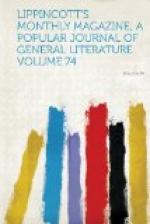Given a family of girls well contrasted, utterly untrammelled, and each in possession of a will and a way of her own, materials for a romance are not hard to find; and in telling the story of the Heathcotes Miss Carey seems to have jotted down a series of events exactly as they fell out in actual life. There is plenty of sentiment, but its expression is dealt out with a sparing hand; there are pretty sylvan scenes, and the wood-paths, the warm homesteads, the meadows and fields, all enter into the story and make a pleasant part of it. If “Barbara Heathcote’s Trial” has no leading motive as strong and as universally interesting as the author’s former book, “Not Like Other Girls,” it is, to our thinking, quite as pleasant and readable, and will no doubt enjoy its predecessor’s popularity.
Romance has done much good work in the way of laying bare men’s faults, hypocrisies, and evil lusts, and if Mormonism is actually on the increase among us there is good reason for a novel like “The Bar Sinister,” which tells us the story of certain converts to the peculiar tenets of the saints and introduces us into the every-day life of Salt Lake City. That our families and our institutions are in peril from this monstrous and ridiculous evil it would not be easy for us to believe. Yet it is impossible to read this book without a conviction that the author could easily substantiate his facts by proofs, and that intelligent men and women have been and are still being led away into the heresy. The incidents of the story are, however, calculated to shock and repel the reader, who rises from its perusal sick and indignant as much from having been confronted with such personages and their doings as from the fact that such people are in existence. The author has without doubt enjoyed the advantage of a flesh-and-blood acquaintance with leaders of the faith who talk unctuously of “Class No. 1, 2, 3, 4,” etc.; and, besides actual knowledge, there is strong feeling and earnest principle behind the whole narrative.
“Pine-Cones” is a pleasant story for young people, telling the adventures of a party of boy and girl cousins making a visit among the great pine woods of Maine. There is plenty of open air in the book, bright talk, and earnest stories told round the fire.
“An Old Maid’s Paradise” is a bright little sketch of the adventures and misadventures of a woman who builds a cottage on Cape Ann promontory for five hundred dollars, and settles down to a joyful existence without any need of aid or comfort from living man except as a purveyor and burglar-alarm. Every one likes to know the price of things, and it is pleasing to understand exactly what may be done with five hundred dollars. “The cottage,” as described by Miss Phelps, “contained five rooms and a kitchen. The body of this imposing building stood twenty feet square upon the ground. The kitchen measured nine feet by eight, and there was a wood-shed three feet wide, in which Puella managed




